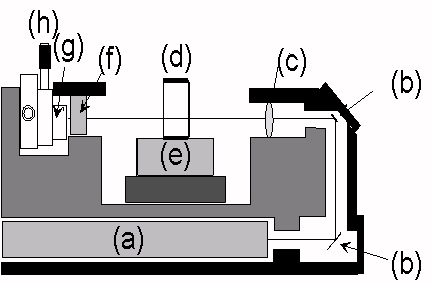The Mirage Effect (Photothermal Beam Deflection)
The ''classic mirage block''.
 A compact setup which integrates sample displacement stage, as well as the
probe laser and optics has been described by Charbonnier and now
enjoys celebrity status as a basic setup upon which a large majority of
mirage experiments are founded. A commercial version exists, as
well as numerous ''standard'' variants for different applications. The block
is shown here.
A compact setup which integrates sample displacement stage, as well as the
probe laser and optics has been described by Charbonnier and now
enjoys celebrity status as a basic setup upon which a large majority of
mirage experiments are founded. A commercial version exists, as
well as numerous ''standard'' variants for different applications. The block
is shown here.
The base of the block serves as housing for the HeNe or diode probe laser
(a). The beam is directed by aluminum mirrors (b), then passes through a
glass lens (c) which focuses the beam at the center of the sample (d), which
is positioned by the sample holder and stage (e). The beam then passes
through an interference (optical notch) filter (f) which rejects stray
reflections and is directed onto a photodiode position sensor (g), also
positioned on an x-y stage. The mirage signal is detected by the position
sensor (photodiode pair), associated to a Lock-in amplifier.
Interaction Geometry
In a perpendicular interaction geometry, the probe beam passes parallel to
the sample surface through the locally heated adjacent medium. The
information that we wish to measure will then determine our choice of 1 D or
3 D interaction. A 1 D geometry is typically used for spectroscopic
measurements, while in the case of 3 D interaction, the gradient expressed
above must be evaluated along the tangental component in addition to the
normal, allowing us to measure such parameters as thermal diffusivity. In
the case of transparent samples, colinear interaction between the two beams
may also be chosen, that to say that the axii of the two beams will be
aligned or at a slight angle . A diagram depicting the geometries available
is shown below; a perpendicular geometry is shown on the left,
and a colinear geometry shown on the right.

 A compact setup which integrates sample displacement stage, as well as the
probe laser and optics has been described by Charbonnier and now
enjoys celebrity status as a basic setup upon which a large majority of
mirage experiments are founded. A commercial version exists, as
well as numerous ''standard'' variants for different applications. The block
is shown here.
A compact setup which integrates sample displacement stage, as well as the
probe laser and optics has been described by Charbonnier and now
enjoys celebrity status as a basic setup upon which a large majority of
mirage experiments are founded. A commercial version exists, as
well as numerous ''standard'' variants for different applications. The block
is shown here. 